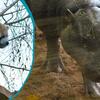The first female eastern mountain bongo calf born in over a decade offers new hope for a Critically Endangered species
Woburn Safari Park has welcomed the birth of a female Eastern mountain bongo calf, a rare and significant milestone for one of the world’s most endangered large mammals. With fewer than 100 individuals remaining in the wild, confined to fragmented pockets of confined to Kenya’s high-altitude montane forests - dense, misty habitats that are home to some of Africa’s most elusive wildlife. This birth represents a vital step forward for this antelope species on the brink of extinction.
Eastern mountain bongo have suffered devastating losses due to habitat destruction, poaching and disease. Every successful birth in a managed breeding programme is a meaningful contribution to their conservation. Born at approximately 8:15am on 3rd October, this calf is the first female of her kind born at Woburn Safari Park in over a decade - a hopeful sign for the future of the species.
The calf’s mother, Othaya, is a familiar favourite among visitors. One of twins and already mother to male calf Djembe, born at Woburn last year. Due to Othaya’s previous challenges during Djembe’s birth, Head of Section, Tom Robson monitored her closely throughout the night. Tom said:
“This is Othaya’s second calf, and she struggled giving birth to her first, so we checked her frequently throughout the night. Thankfully all was well and we’re happy to see a strong-looking calf. Othaya struggled to feed the new arrival at first, so we provided a supplement, but now mum is doing a great job. We’re all very pleased, as it’s a female calf she will hopefully go on to breed in the future and play a part in the survival of the bongo species.”
The birth of this baby bongo is not only a rare event; it’s a strategic win for global conservation. As part of an endangered species breeding programme, her arrival strengthens Woburn Safari Park’s role in reversing the decline of Eastern Mountain bongos.
Already, the calf is showing signs of healthy development and has begun bonding with her older siblings, Djembe and Ziggy, both born at Woburn in recent years.
With her vivid chestnut coat marked by white stripes, the young bongo calf showcases the species’ natural camouflage - a striking adaptation that helps them vanish into the dappled light of forest understorey. Her oversized ears, finely tuned to detect the faintest rustle or call, are not only visually distinctive but vital for survival in dense, echoing terrain. These features, while visually arresting to visitors, are evolutionary tools honed for life in one of Africa’s most elusive habitats.
Related Members
-
News
 Belfast Zoo helps to bring Christmas joy to Children’s Hospital 19th December, 2025Belfast Zoo joined the Lord Mayor of Belfast, Councillor Tracy Kelly, on Monday (15th December) to help bring festive cheer to the Royal Belfast Hospital…
Belfast Zoo helps to bring Christmas joy to Children’s Hospital 19th December, 2025Belfast Zoo joined the Lord Mayor of Belfast, Councillor Tracy Kelly, on Monday (15th December) to help bring festive cheer to the Royal Belfast Hospital… -
News
 Colchester Zoological Society welcomes new arrivals 19th December, 2025This December, Colchester Zoological Society (CZS) welcomed some exciting new arrivals! A young male pygmy hippo, Mikolas, from Zoo Dvur Kralove…
Colchester Zoological Society welcomes new arrivals 19th December, 2025This December, Colchester Zoological Society (CZS) welcomed some exciting new arrivals! A young male pygmy hippo, Mikolas, from Zoo Dvur Kralove… -
News
.png?w=100&h=100&zc=1&f=jpeg&hash=8d175f93cde920c5ba23c8ea7f92e55a) Blog: Understanding the human side of zoos 16th December, 2025Why are zoo researchers increasingly looking to social science? Dr Nieky van Veggel explains the significance of understanding the human dimension…
Blog: Understanding the human side of zoos 16th December, 2025Why are zoo researchers increasingly looking to social science? Dr Nieky van Veggel explains the significance of understanding the human dimension…

.png?w=100&h=50&zc=1&f=jpeg&hash=364a03a1208b9a70ab4fd973c9b0a84d)

